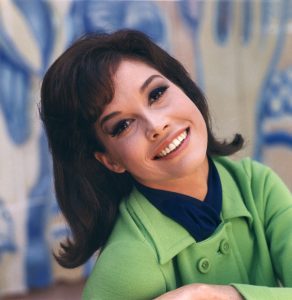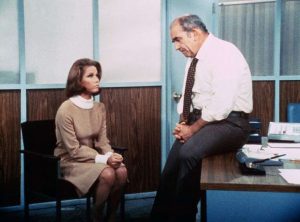 Mary Tyler Moore, who played TV’s first sexy housewife and then a single, career woman who could turn the world on with her smile and toss her hat in the air like no other, died on Wednesday. She was 80.
Mary Tyler Moore, who played TV’s first sexy housewife and then a single, career woman who could turn the world on with her smile and toss her hat in the air like no other, died on Wednesday. She was 80.
Her longtime rep issued a statement: “Today, beloved icon, Mary Tyler Moore, passed away at the age of 80 in the company of friends and her loving husband of over 33 years, Dr. S. Robert Levine. A groundbreaking actress, producer, and passionate advocate for the Juvenile Diabetes Research Foundation, Mary will be remembered as a fearless visionary who turned the world on with her smile.”
A Type 1 diabetic, Moore had long suffered a variety of health problems, and in May 2011 underwent elective surgery to remove a benign tumor of the lining tissue of the brain. “I do have problems with my eyes, one eye in particular, and if I fall, I generally break a bone,” she told The New York Times in early 2012 from the Greenwich, Connecticut, home, she shared with Dr. Robert Levine, her husband since 1983, and their four dogs.
Moore was diagnosed with diabetes at 33, and “I thought I’d have to recline on a chaise the rest of my life,” she stated in 2009. After that, she said, “there have been challenges, but I’ve triumphed.”
That she did, capturing America’s heart in the process.
 Not only was the beautiful brunette with the big brown eyes and distinctive voice a certifiable TV legend, with two indelible characters to her name — Laura Petrie on The Dick Van Dyke Show from 1961-66, and Mary Richards on The Mary Tyler Moore Show from 1970-77 — but for the past several years she was a tireless advocate for two causes that also remain part of her legacy: animal rights and juvenile diabetes research.
Not only was the beautiful brunette with the big brown eyes and distinctive voice a certifiable TV legend, with two indelible characters to her name — Laura Petrie on The Dick Van Dyke Show from 1961-66, and Mary Richards on The Mary Tyler Moore Show from 1970-77 — but for the past several years she was a tireless advocate for two causes that also remain part of her legacy: animal rights and juvenile diabetes research.
In the ’70s, she was also a behind-the-scenes TV powerhouse at MTM Enterprises, formed with her then-husband Grant Tinker and responsible for such landmark shows as Rhoda, The Bob Newhart Show, Lou Grant and Hill Street Blues.
Reversing the usual trend of film stars who moved into TV, Moore did the opposite: going on to the big screen in triumphs that included an Oscar nomination for 1980’s Ordinary People. She was also given a special Tony Award for her Broadway role in the Brian Clark drama about harsh decisions faced by a once-vital sculptress paralyzed below the neck after a car accident, Whose Life Is It Anyway?
Unfortunately, Moore personal life was seldom as sunny as the TV roles she played. As PEOPLE Magazine said of the star in a 1980 profile, she was stifled as a young woman in the strict Roman Catholic atmosphere of her parents’ Los Angeles home when she married a 27-year-old food broker named Richard Meeker.
 Their son Richie came along 11 months later, when Moore was 18. By the time he was 3, she had steady work on TV. When he was 6, she and Meeker divorced. Six months later, she married Tinker, who had four children from a previous marriage.
Their son Richie came along 11 months later, when Moore was 18. By the time he was 3, she had steady work on TV. When he was 6, she and Meeker divorced. Six months later, she married Tinker, who had four children from a previous marriage.
The heavy workload of both parents left little time for their children. “I demanded a lot of Richie,” Moore later admitted. “I was responsible for a lot of alienation.”
Their relationship grew strained as Richie grew up and rebelled, and for a long period mother and son were estranged. They did reconcile, and Richie even began landing some small acting roles on TV. But in a 1980 accident, Richie died of a self-inflicted gunshot wound. He was 24.
“I have never seen Mary so distraught,” MTM colleague Gavin MacLeod told PEOPLE. Moore, Tinker, Meeker and his second wife took Richie’s ashes to a beautiful, desolate area of the Sierras that he had loved and scattered them in the Owens River.
With the help of her psychotherapist, Moore began to deal with the tragedy. To keep going, she kept busy. More than 6,000 letters of condolence had come in. Hour after hour, Moore sat and answered them in her own hand.
 Looking ahead, she decided the sooner she got back to work the better. She hired a story editor to find her a new movie — drama or comedy, just so it was good — and as the scripts arrived she read them.
Looking ahead, she decided the sooner she got back to work the better. She hired a story editor to find her a new movie — drama or comedy, just so it was good — and as the scripts arrived she read them.
Moore candidly recounted the tragedy in her 1995 memoir After All, which also chronicled her troubled marriages and struggle with alcoholism. A second book of hers, 2009’s Growing Up Again: Life, Loves, and Oh Yeah, Diabetes, addressed her disease.
Though less active as she grew older, Moore recently turned up as the jail cellmate on her former Mary Tyler Moore Show costar Betty White’s sitcom Hot in Cleveland. Next to prisoner Mary’s bed behind bars was a large M, just like the one that used to adorn the wall of Mary Richards’s first Minneapolis apartment.
“Stands for murder,” Moore said, earning a big laugh from the audience.
At the 2012 Screen Actors Guild Awards, where she was given a Life Achievement Award, Moore, introduced by Dick Van Dyke, told how there were six other Mary Moores belonging to the union when she started in the business. Rather than change her name, as she was advised, she used her middle name — which was also her father George Tyler Moore’s middle name — and signed up with SAG as Mary Tyler Moore.
That way, she said, she made her father happy, “and tonight,” she told the adoring crowd, “after having the privilege of working with the most creative and talented people imaginable, I, too, am happy, after all.”
Did you know that if you subscribe to our website, you will receive email notifications whenever content changes or new content is added.
1. Enter your e-mail address below and click the Sign Me Up button.
2. You will receive an email asking you to confirm your intention of subscribing to our site.
3. Click the link in the email to confirm. That’s all there is to it! Note: if you wish to unsubscribe from our site, click the unsubscribe link at the bottom of the email you received.
Then indicate you no longer wish to receive our emails.
Thank You
Dialect Zone International